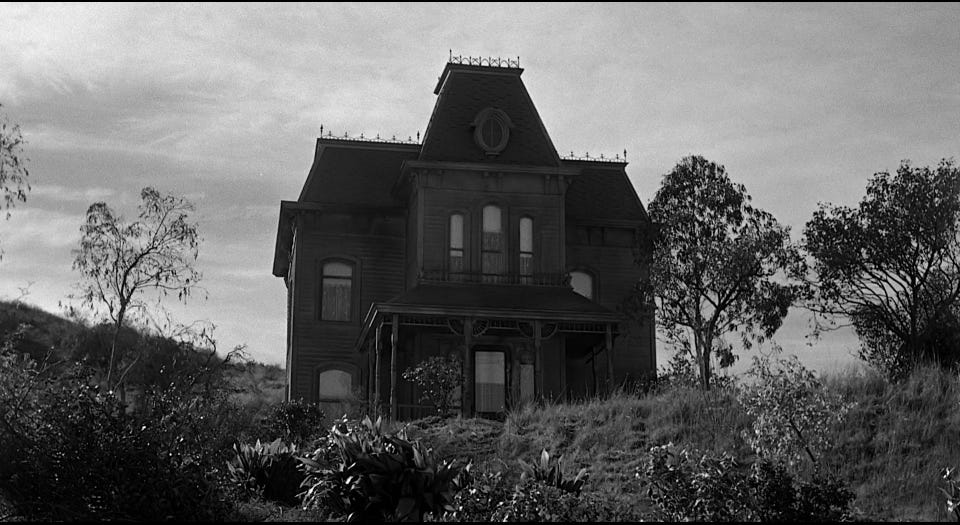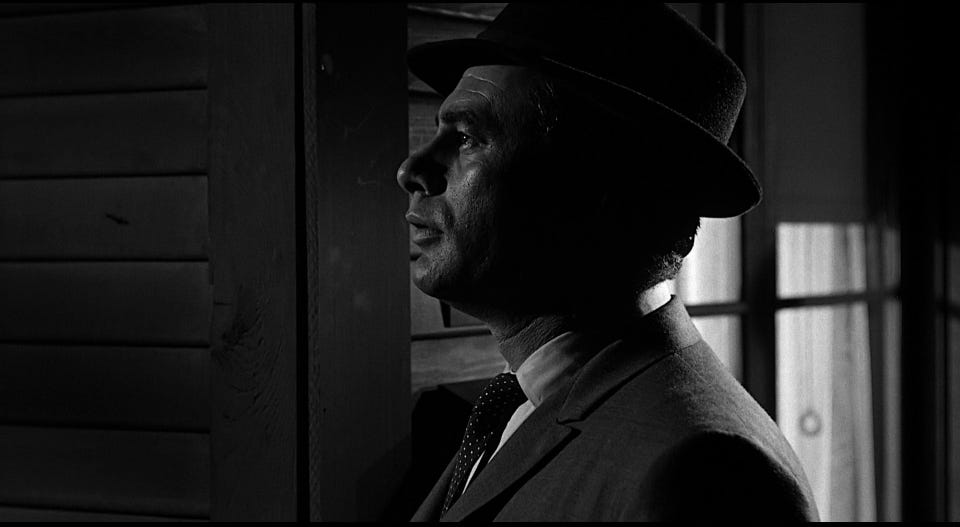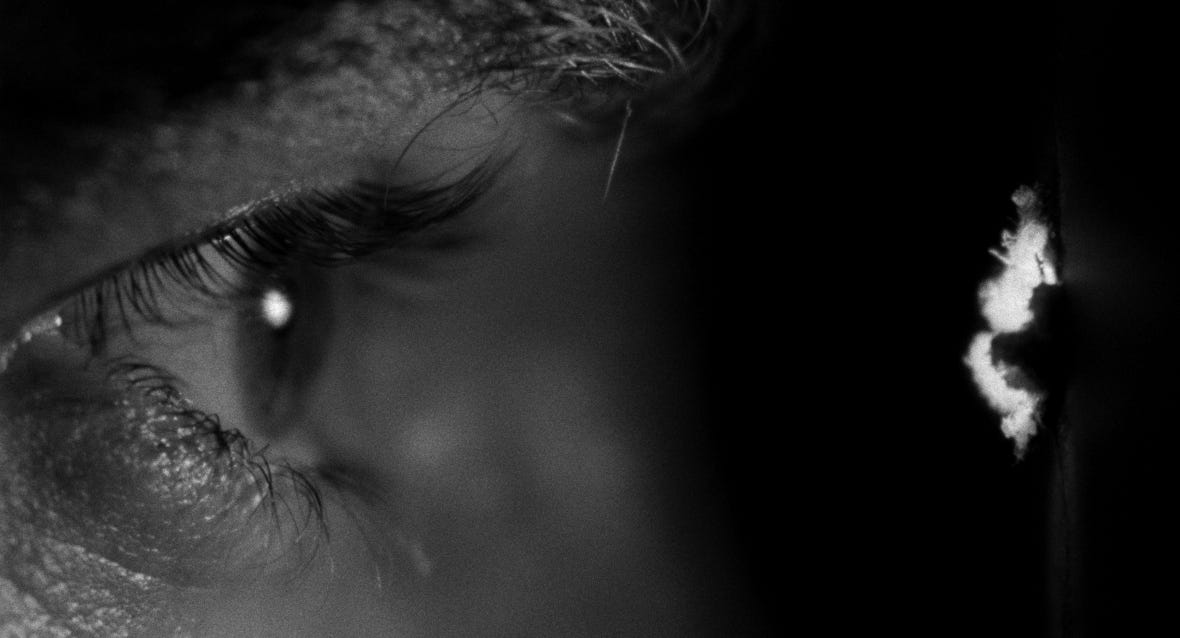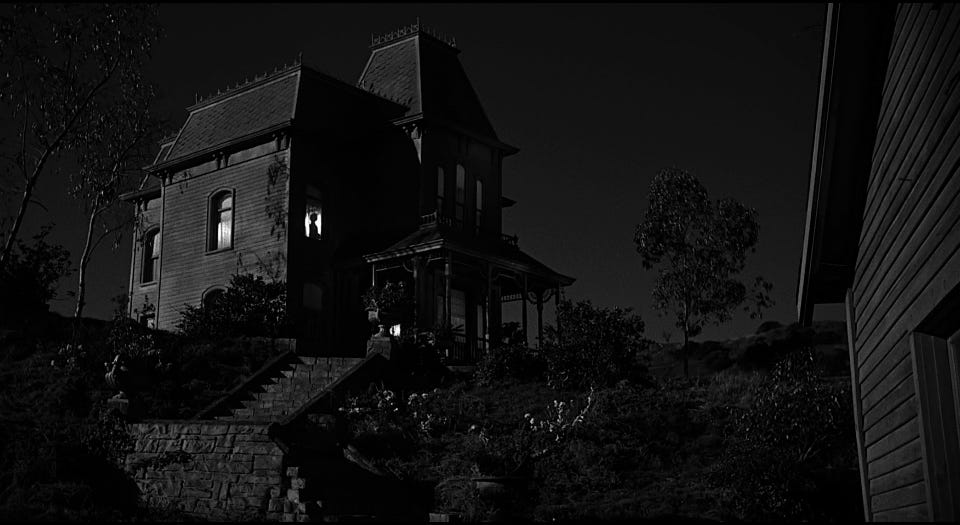Robert Bloch. Three Complete Novels. Wings Books, 1993 [1959]. 503 pp.
It’s time for another novel-to-screen letter, and yet another spooky tale.
Alfred Hitchcock was already at the top in the late 50s, that’s why he elected to parody himself with North By Northwest (1959), and with Psycho he pivoted away from sumptuous VistaVision to grungy black-and-white; no one thought it would work.
But it did work, so well that it revised the blueprints for exploitation film.
In videogames, the history of a given genre is easily traced: it’s usually a series of attempts to copy one game. Before they got their modern label, “First-person Shooters” were known as “Doom clones” for example, and today there are Roguelikes, Rogue-lites, Souls-likes, etc.
Surely it’s the same thing with slashers and Alfred Hitchcock’s Psycho (1960) — every piece of slash ‘n’ trash is overtly indebted to this single film and its kitchen knife. Even the characters’ names get reused in homage: Crane, Loomis, Arbogast, Bates…
Bloch had cooked with a winning recipe, essentially a southern gothic dressed up in the terms of trendy mid-century psychoanalysis. It makes sense to sell the novel as a “Chiller,” for it’s really the psychological mess inside Norman that’s most graphic and disturbing, more so than the kills, which are no worse than what you could read in pulp crime fiction of the 30s onward. Look at this terrible phantasy with all the required imagery of trauma (muck):
He could see Mother, and she was in the swamp. That's where she was, in the swamp, she'd blundered down the bank in the darkness and she couldn't get out again. The muck was bubbling up around her knees, she was trying to grab a branch or something solid and pull herself out again, but it was no use. Her hips were sinking under, her dress was pressed tight in a V across the front of her things. Mother's thighs were dirty. Mustn't look.
But he wanted to look, he wanted to see her go down, down into the soft, wet, slimy, darkness. She deserved it, she deserved to go down, to join that poor, innocent girl. Good riddance! In a little while now be free of them both — victim and victor, Mother and the bitch, bitch-Mother down there in the dirty slime, let it happen, let her drown in the filthy, nasty scum —
Now it was up to her breasts, he didn't like to think about such things, he never thought about Mother's breasts, he mustn't, and it was good that they were disappearing, sinking away forever, so he'd never think about such things again.
Yeah, I’m thinking there’s a screw loose!
It turns out the movie is essentially follows the novel beat for beat, deviating only in some small details and one large story decision. Where Hitchcock moves the camera through an apartment window in Phoenix, Arizona, in the novel we begin with Norman in the “Psycho House” reading a “grotesque” non-fiction book on the Inca practice of flaying a man to use his skin for a drum.
(This business of reading characters reading, as well as the details of Mary Crane’s financial dissatisfaction, made me think Bloch is the biggest and most direct influence on Stephen King, in terms of narration.)
Bloch’s writing has to walk a fine line of suspense of whether or not Norman’s mom actually exists. In the movie we hear an old woman’s voice, always off screen. Here the ambiguity comes Norman’s internal speech, in a process of self-obscuration.
This one difference seems fundamental. It’s the reason why the film Psycho was taken as so radical. People weren’t ready for Janet Leigh to be victimized so soon into the picture, so the audience was thrown for a loop. Whereas in the book we know from the start that Norman-Norma Bates is the heart of this story.
Another salient difference — and the main point on which the Hitchcock improves substantially on the Bloch — comes from the casting. Norman Bates in the book is a large man, really a big kid, but the handsome and expressive Anthony Perkins seems more disarming, while still projecting a boyish nervousness and a little bit of livewire menace.
The private investigator Arbogast is a rather unimaginative gruff type in the novel, but in the movie this role gets a boost from the great character actor Martin Balsam (Juror #1 himself!), who comes across equally avuncular and assured. He quietly builds up a lot of credence in the audience for his small amount of screentime.
Another invention of the film: the consistent use of a kitchen knife for stabbing. In the book Mary Crane is done in by a meat cleaver in a swift decapitation, and Arbogast by a shaving razor. Maybe the knife was a better fit for a movie logistically speaking, but in any event, as far as pop culture is concerned, the image of this weapon has stuck. (Pun intended.)
The element I was most surprised to see had been taken up from the novel is that interminable scene at the end, when Simon Oakland as some doctor yaps away about Norman’s oedipal struggle. It’s so boring! And it’s worse in the book because it’s reported secondhand from Crane’s fiancée Loomis, but it’s all there, the tripartite-split personality and everything.
One general inversion between the book and the film is that the best part of the novel is at the climax, when Lila Crane explores the Psycho House on her own — the previous kills are more delectable in the film while the book had focused on the buildup.
But here, with Lila poking around this old mansion that would fit better in Mississippi than SoCal, the narration gives insight to her personality. She’s more educated (and impatient) than the rest of the cast. She spontaneously reacts to these antique interiors:
For the decor of this room had been outmoded many years before Bates's mother died. It was a room such as she thought had not existed for the past fifty years; a room that belonged in a world of gilt ormolu clocks, Dresden figurines, sachet-scented pincushions, turkey-red carpet, tasseled draperies, frescoed vanity tops and four-poster beds; a room of rockers, china cats, of hand-embroidered bedspreads and overstuff chairs covered with antimacassars.
She has enough taste and experience to identify how old this stuff is, and to be reflexively repulsed: “Here were the short skirts of a quarter of a century ago; up on the shelf the ornate hats, the head-scarves, several shawls such as an older woman might wear in a rural community.”
This one little passage made me feel more “postmodern” than anything else in today’s media. We seem to be comfortable enough with the past, at least with the safe representations of it. But for Lila Crane, a young woman at the beginning of the 60s, experiencing a long post-war economic and cultural boom, the past is unambiguously negative and haunting.







